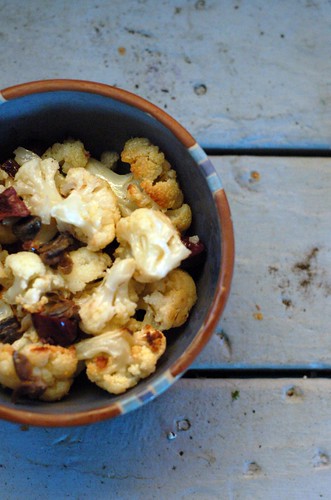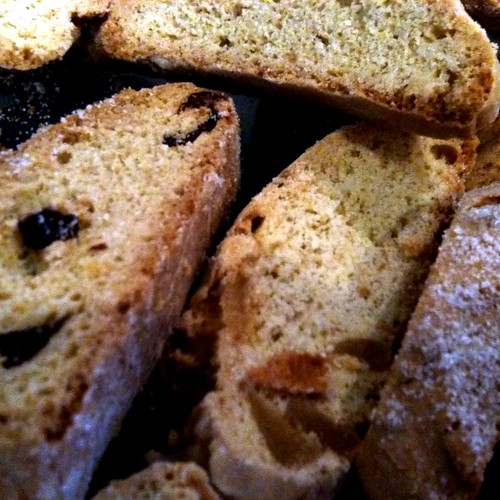Cauliflower - the brains of the vegetable world
 Wednesday, November 3, 2010 at 10:06PM
Wednesday, November 3, 2010 at 10:06PM
Growing up, one of our dorky family traditions was to boil up a cauliflower on Saturday afternoon and eat it. Yes, you read correctly, boil the hell out of a head of cauliflower and eat it with some salt, pepper and
lemon juice. If we were daring, we might venture to the sublimeness of boiled turnips. We lived
large back then - cauliflower, the Rockford Files and a nap. Saturdays were great nap days.
The smell of boiled cauliflower leads most to wrinkle their noses up and stare at the dog. It is not
a pleasant smell and it is a smell that lingers. Cauliflower is much maligned - its the last
vegetable left on the veggie tray, the vegetable that looks much like your brain on cauliflower, the vegetable that turns grey with over cooking, over smothered with orange cheese sauce and the vegetable most likely to be fed to the aforementioned dog.
It is a vegetable that shines with tossed with olive oil and roasted. It becomes a whole other
creature -- sweetened, caramelized and savory at the same time. Tonight I was honored to be invited
to a small gathering to honor Amanda Hesser. The guests were asked to cook things out of her various
cookbooks and other New York Times cookbooks. I couldn't locate our NYT International Cookbook, so I
borrowed the The New York Times Country Weekend Cookbook from the library to see what I could find.
Hesser's take on Mario Batali's Roasted Cauliflower had me hooked. It hit the key points necessary
for potluck friendly food - easy to prepare, easy to double, best served at room temperature and
keeps for a day in the fridge and in fact tastes better with a little sitting around. The recipe is really entitled - Roasted Cauliflower with lemon, olives and capers is a amazing mix of flavors. The sweetness and caramel flavors of the cauliflower, mixed in the tart lemon juice and lemon rind, a touch of garlic (just a touch, not overwrought) and the saltiness of
the capers and meatiness of the olives.
Its a keeper.
The original recipe calls for a lot of olive oil. I was aghast at the amount. You need to use the oil
in three steps, cauliflower roasting, marinating and olive and caper desalting. You can limit the
amount of oil for the marinating, and discard the oil from the desalting. It all works out in the
end.
The recipe also calls for salted cured capers, these are an extravagance, but well worth it. They are
typically larger than the average brined caper and work beautifully paired with the olives.
Mario Batali's Roasted Cauliflower with lemon, capers and olives - From the New York Times Country Weekend Cookbook (2007).
Makes six generous side servings or 12 as nosheri
Time to make recipe ca. 1 hour, not all active time
Ingredients:
2 medium head of cauliflower cut into florets
salt and pepper
Approximately 2 cups good extra virgin olive oil to be divided and used for three different stages of the recipe
3 cloves garlic, peeled with green germ removed (halve the garlic)
2 T fresh thyme leaves, I used 1 T dried
Grated zest of 2 lemons, reserve lemon juice for end of recipe
3 T salt cured capers, rinsed and dried
1/3 cup kalamata olives, chopped
Heat oven to 375. Measure and cut a piece of parchment paper to fit in a jelly roll pan or large baking sheet. Place washed cauliflower florets in bowl, add salt and pepper and toss to distribute evenly. Pour 1/3 cup olive oil in bowl and and gently toss to coat the florets. Spread cauliflower on jelly roll pan.
Roast in oven until cauliflower starts to brown and gets soft. You will want to check every 10
minutes and rotate the tray every ten minutes. The roasting should take approximately 30 minutes.
When completed, remove tray from oven and let cauliflower cool.
While the cauliflower is roasting, combine 1 cup of olive oil, garlic, the lemon zest and thyme in a heavy,
but small pan. Place pan on burner to heat, but not boil You should have the oil bubbling gently. I
used a small copper sauce pan and had to keep my burner on a low heat. Check after about 20 minutes
to see if garlic is softened. When softened, remove from heat and let cool. When the oil has cooled
to room temperature, either use a blender or immersion blender to puree garlic into the oil.
In a separate pan, add the remaining oil, capers and olives together and warm for five minutes. Note:
My second making of this recipe - I rinsed the capers, but then just added them to a little oil to
help plump them up. I didn't heat them and they tasted just fine. I skipped adding the olives to the
oil as well. Once capers have plumped, drain oil.
Place cauliflower in a big bowl (you need to toss the mixture), add 1/3 cup of lemon/garlic oil and
toss to coat. You can add a little more of the oil mixtureif you want, but you don't want it dripping
with oil. Reserve the rest of the oil for another use. Add capers and chopped olives, season with
lemon juice and add salt and pepper if you think it might need a little more. The olives and capers
add a lot of salt, but not necessarily onto the cauliflower.
The dish is great at room temperature, but refrigerate if not using soon. Bring up to room temp before serving.
 Amanda Hesser,
Amanda Hesser,  Mario Batali,
Mario Batali,  cauliflower,
cauliflower,  gluten free,
gluten free,  potluck,
potluck,  recipe,
recipe,  vegan in
vegan in  recipes
recipes 







